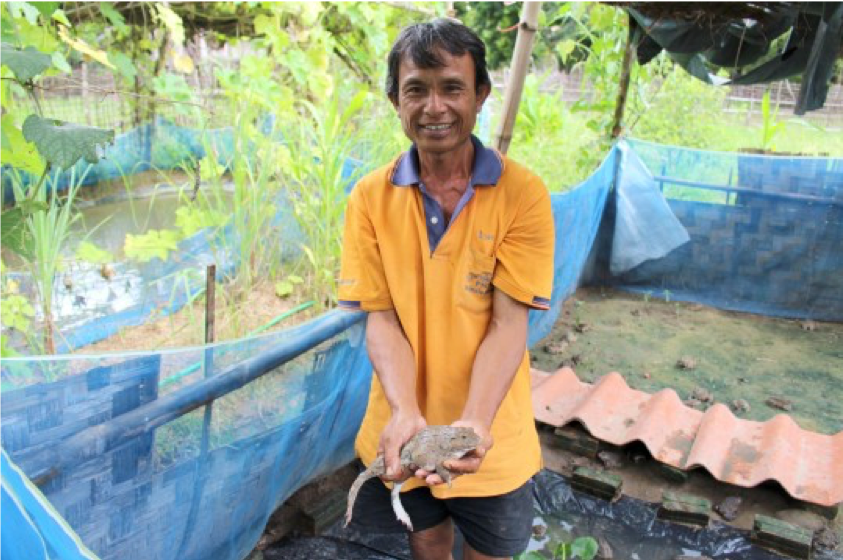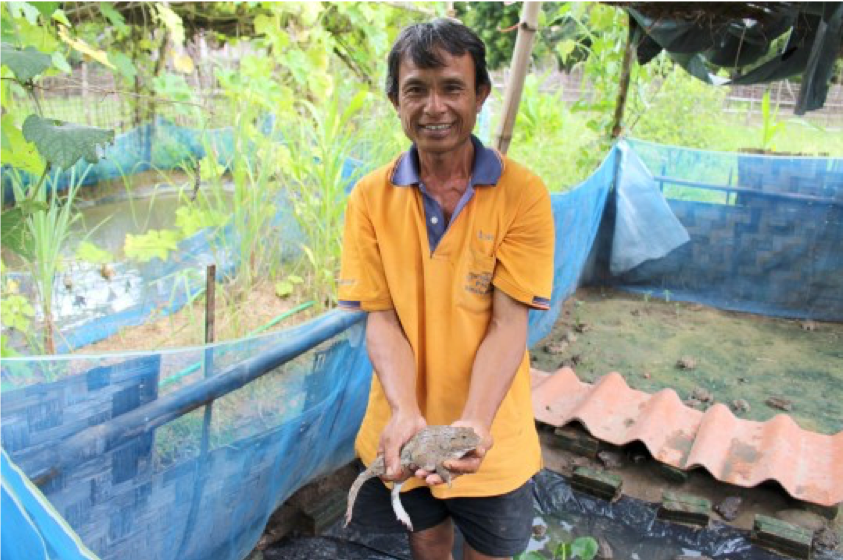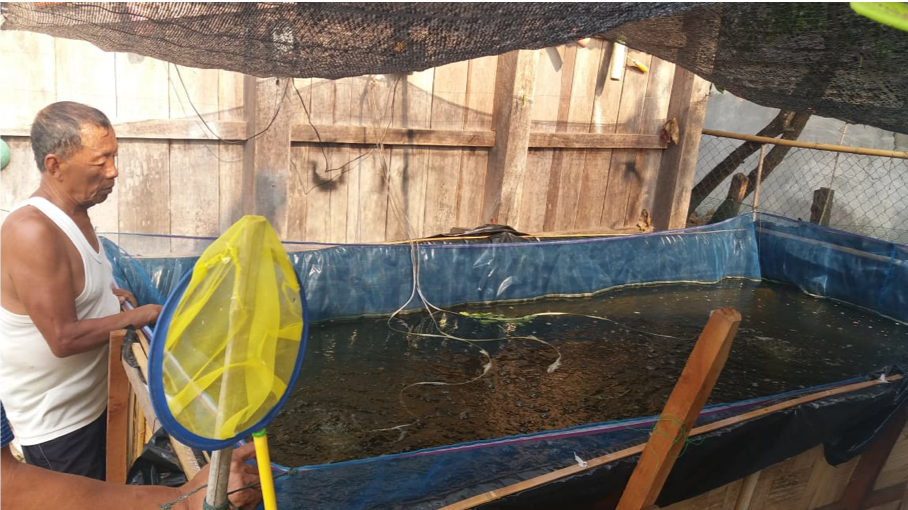
From fins to feathers: the power of trial and error
– January 2019 –
By Lampheuy Kaensombath and Syphachan Vannasy –

Photo: UNDP Lao PDR/Somlith Khounpaseuth
Fall down seven times, stand up eight
This old Japanese proverb is meant to encourage people to see what many might call ‘failure’ as an opportunity to learn and grow. The CDAIS experience with the aquatic animals and rice niche in Laos offers a good illustration of how that principle works in practice.
In 2016, CDAIS began working with a small group of farmers from Nongkhamhed and Phintai villages in Outhoumphone District, Savannakhet Province. There were 10 farmers who had been involved in a previous FAO project and had also received training from a government programme in 2015 but little had happened since. One farmer in particular, Mr Bounlom Phanthavong, was the main driver in the group and was enjoying reasonable success.
“From the first four frogs, I now produce 1000 frogs per year, I keep 200 for breeding and sell 800 at about US$4.20/kg or about one dollar a frog” said Mr Bounlom Phanthavong. “In addition to the sale of frogs, the money I make from selling tadpoles and eggs to other farmers and traders, I can earn up to US$1000 a year! And this is on top of the US$1200 per year I earn from the sale of tilapia and fish fry. My ponds earn me good money.”
Few others had followed his lead, and when CDAIS came on the scene the group had dwindled to just five members. Syphachan Vannasy, the CDAIS facilitator for the niche recalls, “I thought Mr Bounlom’s success would be enough to rebuild the group, but there were some big challenges.”
Water was one of those issues. Ponds in Outhoumphone are mostly rainfed and the water level drops to very low or none at all from November to May. The more serious challenge was farmers’ fear of taking any financial risk. “We all have seen our neighbours lose their land after taking loans from a bank” said villagers who attended a CDAIS workshop in September 2017. “If you lose your land, your life in the village is over.” A 60 m x 40 m pond and 3 m deep can cost US$1000 or more, and then there is cost of materials for cages, etc. Banks are seldom ‘user friendly’ for smallholder farmers. The loan ceiling is often too low to cover investment costs and the repayment schedule rarely matches the periods in the agricultural calendar when farmers make money, such as after harvesting and selling crops.

Still another challenge for Syphachan was the fixed mindset farmers had about projects. As Syphachan explained, “They kept asking if I could find a trainer to help them improve water quality, so I kept asking them to make a training plan and suggest some experts to contact. They never did, and when I finally did arrange for training, they never followed up.”
Despite these obstacles, Syphachan pressed on, but by 2018 the group had lost a few more members until MrBounlom was the ‘last man standing’. In the meantime, the Lao Ministry of Agriculture had published a new National Agriculture Development Strategy to 2025 and Vision to the Year 2030, and its implementation was beginning to have an effect at the district level. The local DAFO office was therefore quite supportive when Syphachan and the CDAIS monitoring, evaluation and learning team organized a meeting in Nongkhamhed village in April 2018 to review the situation. More than 30 people from Nongkhamhed and Pintai villages attended the meeting, including Mr Bualien from the local DAFO (government) office.

CDAIS facilitator Syphychan meets with members from the old ‘frog’ group to talk about lessons learned and future opportunities. 
Farmers from five villages brainstorm ideas for developing a viable niche partnership at a DAFO supported meeting.
Syphachan, with help from Mr Bounlom and other members from the old group, told the story of their ventures with frogs and fish, and with help from CDAIS national lead facilitator Lampheuy Kaensombath, explained how CDAIS works. People started talking about their past action plan and the reasons why it didn’t work as planned, being mainly technical and financial. By the end of the meeting, half a dozen people had expressed interest in each of three areas: aquatic animals, organic vegetables, and poultry raising.“
“
CDAIS doesn’t enforce a rigid plan, it is for me to decide, and so I learn a lot myself as I work and adapt along with the farmers I work with. We learn together.”Syphachan
Vannasy , CDAIS facilitator.
DAFO was even more supportive at a meeting in July 2018 in Outhoumphone, to learn more about the CDAIS extension management system and innovation support systems. DAFO had already identified poultry raising as the ‘one product’ for their ‘one district’ as outlined in the national strategy, and invited 20 people from five villages (Nondokmai, Pin Nuae, Nongbuathong, Nonvilai, Nongkhamhed) to give their inputs. With backstopping support from CDAIS, DAFO conducted a market survey among chicken vendors in Outhoumphone town. Over the years, the town has become famous for its fried chicken and a ‘food stop’ in Outhoumphone is a must for people travelling between Vientiane and Champasak. Whilst the cooking technique is unique, the chickens come from elsewhere, hence the market opportunity for local poultry raisers and a new CDAIS niche.
Next steps
DAFO is now working on a plan to present to the District Governor, which means there are two critical turning points to manage. First, DAFO needs to see the value in taking their draft plan back to the farmers and the fried chicken vendors, and to revise the plan according to feedback received. Without this step, farmers and vendors will have no ‘ownership’ of the plan and its chances of success are not high. Outhoumphone DAFO also requires capacity development for writing action plans and a change in mindset regarding extension work.
The second critical turning point is to persuade DAFO to develop criteria to select villages to participate in the plan. Syphachan can use experience from other CDAIS niches to draw lessons from and let DAFO staff come to their own conclusions. “Success is never guaranteed” says Sayphachan. “What’s important is we learn from our experience and get up again.”

Prepared by
Lampheuy Kaensombath is national CDAIS coordinator (lampheuyk@gmail.com, +856 02 0 2829 9751). Syphachan Vanassy is CDAIS national innovation facilitator for the aquatic animal and rice niche.
Aquatic animal and rice


